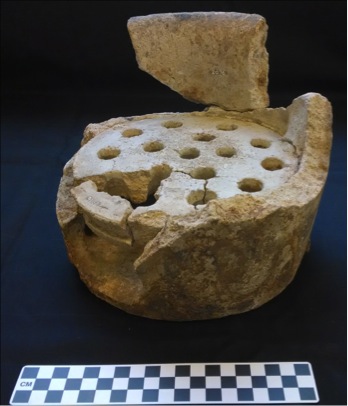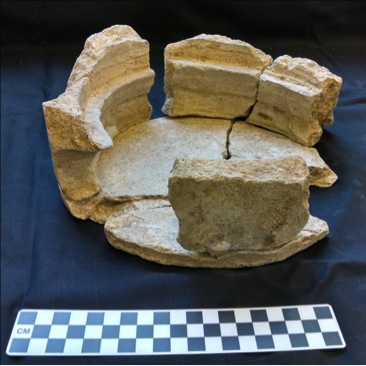January 2014 — Artifact of the Month
back to PAF Home
To Artifact of the Month INDEX
History’s Hotplate! — Portable Earthenware Furnaces


The portable earthenware furnace is an object that very few people are familiar with today, but have been very familiar to someone living in Philadelphia during the middle of the 19th century. Two such furnaces have so far been identified as part of the ongoing analysis of the materials recovered from the National Constitution Center archaeological site located in the Independence National Historical Park in Philadelphia, PA. The most extensive research on these kinds of furnaces was conducted by Susan H. Myers for her 1980 book Handcraft to Industry: Philadelphia Ceramics in the First Half of the Nineteenth Century, and this brief account is based in part on her work.

Portable earthenware furnaces were a consumer product that used novel materials and manufacturing processes to adapt aspects of daily life to the challenges and circumstances of urban living in the new American republic. These furnaces were made of a heat-resistant and porous ceramic commonly referred to in the 19th century as ‘fire’ or ‘refractory’ brick. In addition to its use in kilns, furnaces, and foundries, fire brick was shaped to make portable furnaces – essentially bucket-shaped cylindrical containers used as a portable heating source. These containers had an empty space at the bottom with a fire brick grating in the interior of the bucket and an opening on the side. Coals were placed on the grate while ashes fell into the open space and subsequently were removed via the opening. The whole furnace was wrapped in iron strapping, to improve durability and to help keep the hot fuel and ceramic contained if the furnace shattered. The strapping also typically attached to a handle, to increase portability, and had a cover for the ash-removal hole that slid up and down, to better regulate air flow to, and therefore the temperature of, the fuel. The burgeoning Philadelphia ceramics industry had great success manufacturing and distributing these furnaces throughout the city and the region, with at least eight potteries advertising portable earthenware furnaces around the middle of the 19th century.

Although they were also used as personal heaters and as crucibles in chemistry laboratories, the historical documents suggest the primary use for portable furnaces was for cooking. At a time when heating anything in the kitchen traditionally involved building a fire in an open hearth, cooking in the hot Philadelphia summers would have been something between a sweaty chore and a hellish ordeal. Portable earthenware furnaces were manufactured so vessels of various sizes – from “a small tea kettle” to “a large cauldron” – could nest inside the furnace, drawing heat from the coals on the grate while still allowing air-flow to the fuel source. Not only could a portable furnace cook and/or heat up food and drink without generating as much heat, the ability to cook outside into the relative coolness of the yard would have undoubtedly provided much relief. The furnaces were also much more fuel efficient than an open fire, which would have a valuable economy to working class families. Whether these types of furnaces were used primarily by working class families with inadequate cooking facilities and a meager fuel budget or by middle-class households attracted to their convenience and novelty is a subject of on-going analysis by the Independence Archaeological Laboratory.
Contributed by Alexander Keim, Independence National Historical Park Archeology Laboratory. Images adapted from Keim’s presented talk, Portable Earthenware Furnaces Recovered From the NCC Site (presented at Explore Philly’s Buried Past, 2013).
back to PAF Home
To Artifact of the Month INDEX
by admin